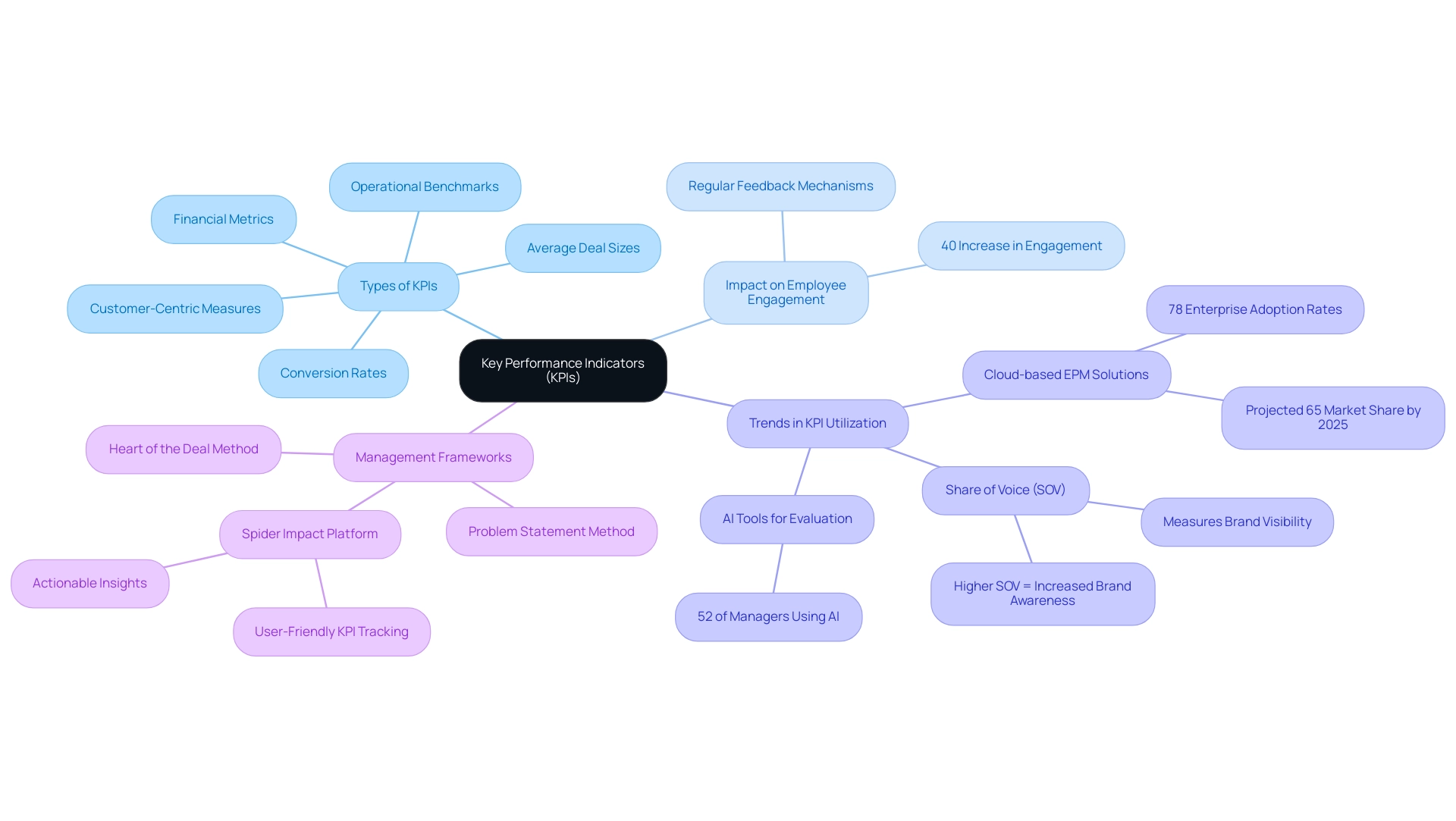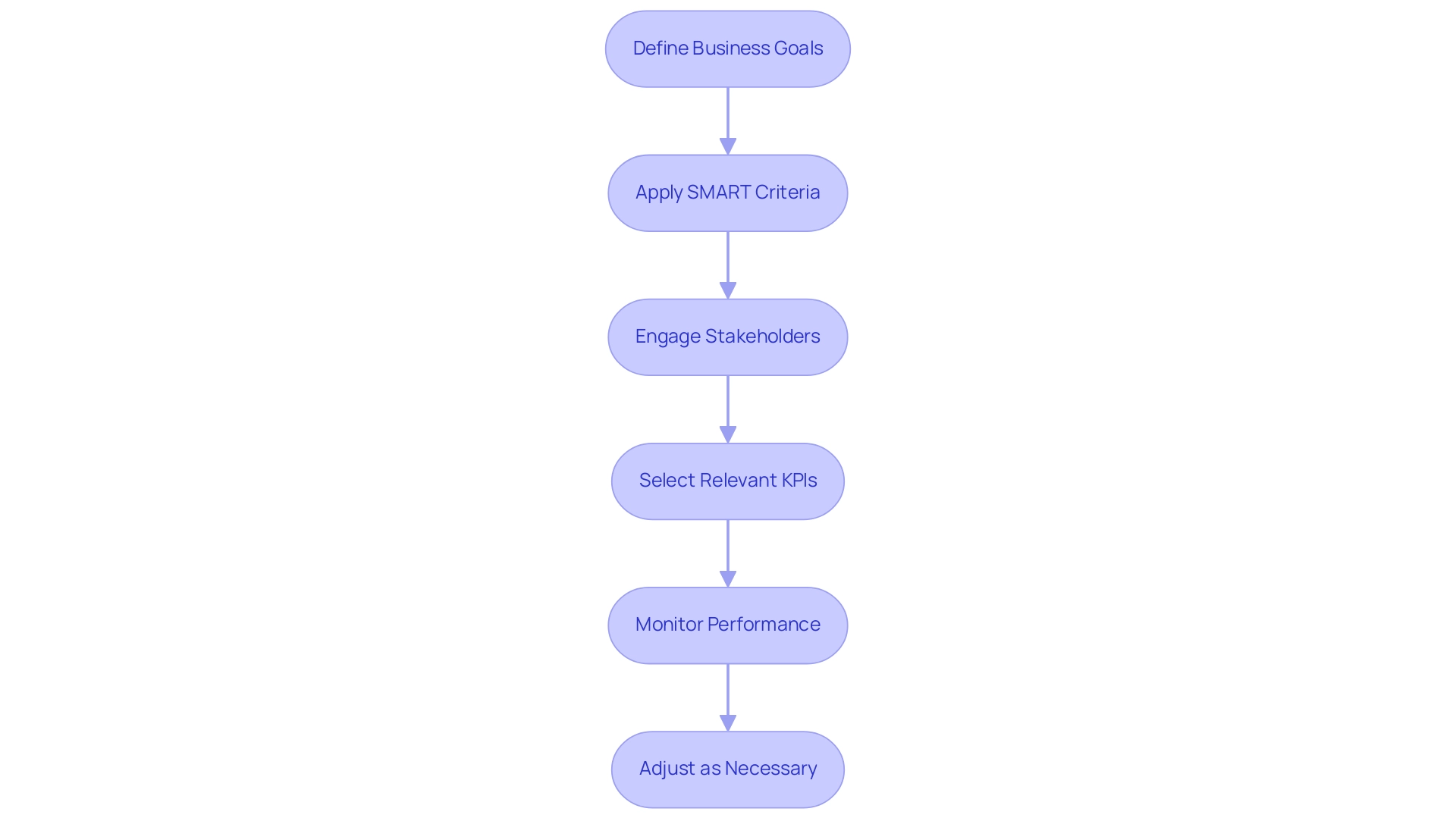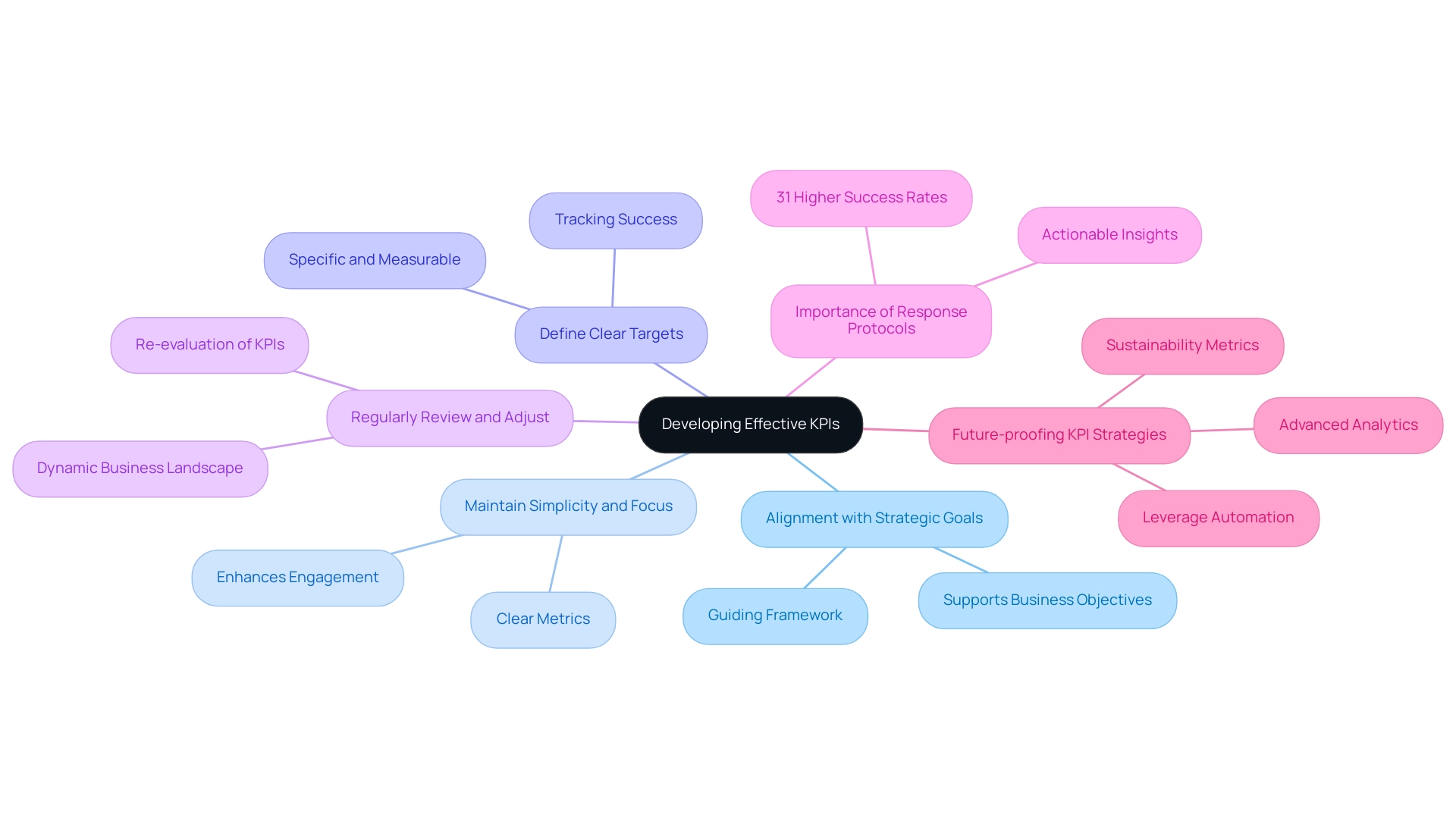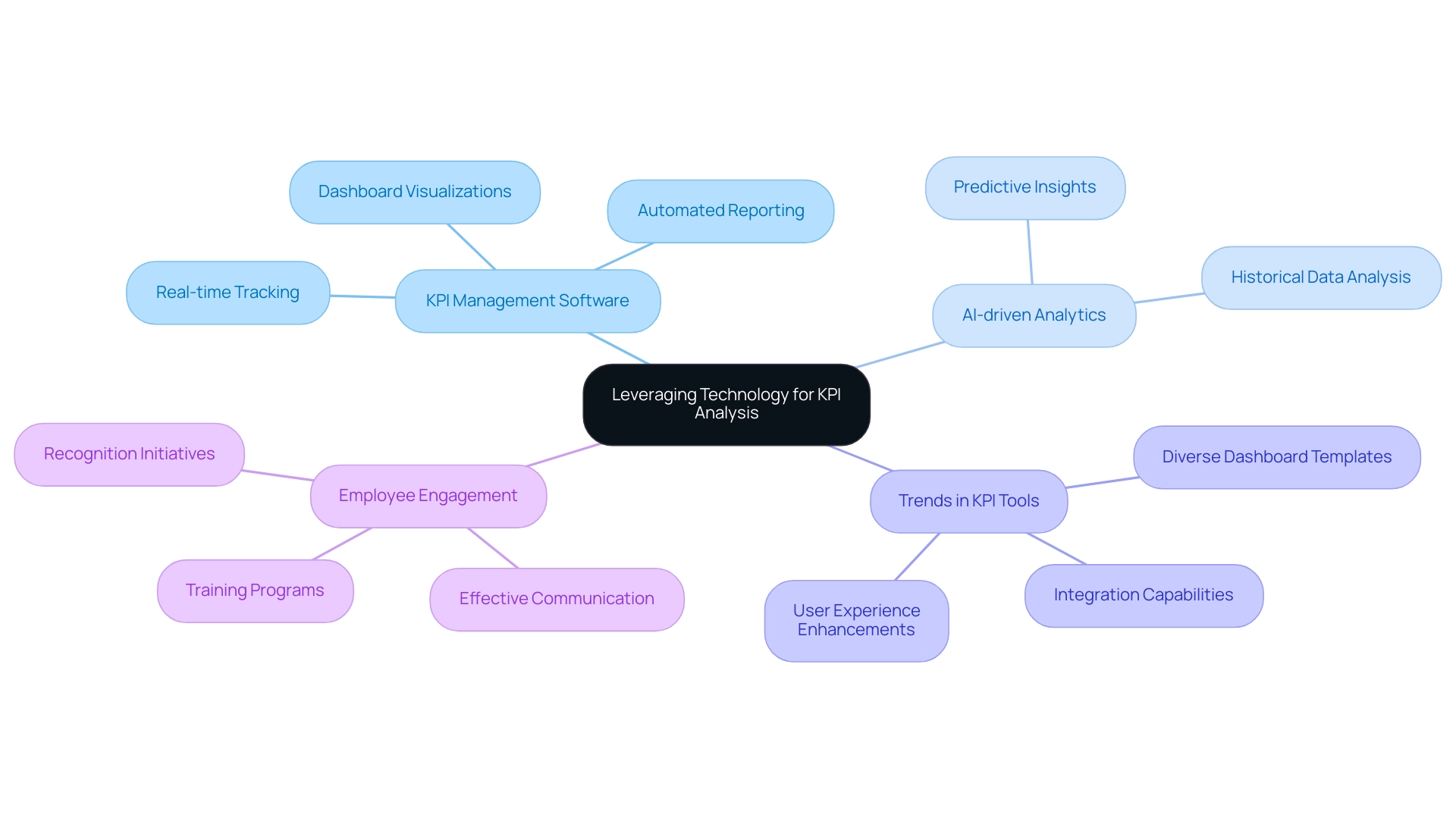
This article presents a comprehensive, step-by-step guide for businesses on conducting KPI analysis, underscoring the critical importance of selecting relevant KPIs that align with strategic goals and employing advanced tools for effective tracking. It elaborates on best practices, such as:
Collectively, these strategies enhance decision-making and drive business success.
In a world where data drives decision-making, understanding Key Performance Indicators (KPIs) is critical for organizations striving to achieve their strategic objectives. These quantifiable measures serve as a compass, guiding businesses through the complexities of performance evaluation and improvement. As digital transformation accelerates, companies increasingly leverage innovative tools and methodologies to track KPIs effectively, ensuring competitiveness in a rapidly evolving marketplace. From enhancing employee engagement to optimizing sales strategies, the insights derived from KPIs empower organizations to make informed decisions that lead to tangible growth and success. As businesses navigate this landscape, the selection, development, and continuous monitoring of the right KPIs become paramount in driving performance and achieving long-term objectives.
Key Performance Indicators serve as essential quantifiable metrics that evaluate a company's performance in relation to its strategic objectives. These indicators encompass financial metrics, operational benchmarks, and customer-centric measures. Understanding key performance indicators is vital for tracking progress and enabling informed decision-making.
Sales teams frequently leverage performance indicators such as conversion rates and average deal sizes to assess their effectiveness and pinpoint areas for enhancement.
In 2025, organizations that implement regular feedback mechanisms are experiencing an impressive 40% increase in employee engagement rates, underscoring the critical role of performance indicators in cultivating a motivated workforce. Additionally, the digital transformation of management systems is accelerating, with cloud-based Enterprise Management (EPM) solutions projected to capture 65% of the market share by year-end, reflecting a surge in enterprise adoption rates to 78%. These trends highlight the necessity for revenue teams to adapt and utilize KPIs effectively to enhance their outcomes.
Recent developments indicate that the Share of Voice (SOV) is emerging as a pivotal KPI for assessing brand visibility in the marketplace. A higher SOV correlates with increased brand awareness, making it a crucial metric for sales teams striving to elevate their market presence. Moreover, expert insights reveal that 52% of managers are already employing AI tools for evaluation.
Grace Smith, a management expert, emphasizes this shift, stating, '52% of managers already using AI tools for evaluation.' This statement illustrates the evolving landscape of KPI utilization and the importance of integrating technology into management practices.
To conduct KPI analysis effectively, it is essential to familiarize yourself with the types of KPIs most pertinent to your business context. Utilizing platforms like Spider Impact, which provides a user-friendly interface for KPI tracking, can enhance your capacity to derive actionable insights and improve management. Furthermore, by segmenting accounts based on customized marketing strategies, organizations can double their productivity and address challenges in quota management and market competition.
This foundational understanding enables you to perform KPI analysis that not only monitors business results but also boosts team efficiency, ultimately leading to improved outcomes and sustained growth. Additionally, enhancing leadership effectiveness through real-time performance insights and tailored coaching can further optimize resource allocation and strategic initiatives.
At Magical Selling, we underscore the significance of frameworks such as the Heart of the Deal Method and the Problem Statement Method to improve effectiveness in transactions. By integrating these customized strategies, organizations can anticipate notable improvements in deal creation, progression, and closing, ultimately achieving higher quota attainment.

Choosing the appropriate Key Performance Indicators is essential for effective KPI analysis and begins with a clear understanding of your business goals. Identify what you aim to achieve—whether it’s enhancing revenue growth, improving customer satisfaction, or boosting operational efficiency. To effectively assess potential performance indicators, apply the SMART criteria: Specific, Measurable, Achievable, Relevant, and Time-bound.
For instance, if your objective is to boost revenue, a relevant performance metric could be the monthly growth percentage of sales. This metric not only provides a clear target but also allows for measurable progress tracking. Engaging stakeholders throughout this process is crucial, as their insights ensure that the chosen KPIs align with the organization’s strategic priorities.
Establishing credibility in your KPI selection process is essential; it demonstrates your commitment to effectively addressing sales challenges and reinforces trust in your decision-making capabilities. Significantly, offering evidence of your assertions and methods is vital to reinforcing this credibility.
Research indicates that organizations adopting clear response protocols for KPI deviations experience a 31% higher success rate in achieving targets. This underscores the importance of not only choosing the right KPIs but also performing KPI analysis to create a structure for continuous monitoring and adjustment based on data. Swift action in response to KPI analysis can turn the tables in your favor, delivering tangible results that impact your bottom line.
Remember, if it works, we can sell it. Moreover, fostering a data-driven culture within your organization can significantly enhance the effectiveness of KPI analysis. According to Gartner, businesses leveraging technology in project management experience up to a 25% improvement in project outcomes. Case studies show that organizations enabling employees to utilize KPI data effectively experience enhanced engagement and ownership, resulting in better outcomes.
By simplifying KPI analysis, leaders can better understand trends and proactively address challenges. Additionally, by integrating KPI tracking into daily workflows and communications, businesses can ensure that performance measurement remains a top priority, ultimately driving sales growth and operational success.

To effectively develop Key Performance Indicators (KPIs), it is essential to adhere to several best practices:
Incorporating these practices can significantly enhance the effectiveness of KPI analysis development. Organizations that establish clear response protocols for KPI deviations have been demonstrated to attain 31% higher success rates in reaching targets. This statistic highlights the significance of not only establishing key indicators but also having practical strategies ready to address variations in results.
Moreover, leveraging automation, sustainability metrics, and advanced analytics can future-proof KPI strategies through KPI analysis, thereby enhancing performance measurement and ensuring that organizations remain competitive. As Priya Kumari from Valasys Media observes, 'Having a visual appeal is important when reporting business performance indicators, which is what compels marketers to look beyond traditional Excel reports or PDFs.' By converting metrics into strategic insights, businesses can take targeted actions that directly impact their success, as demonstrated in various case studies where organizations have effectively aligned their KPIs with strategic goals.

To conduct a thorough analysis of KPI data, begin by gathering pertinent information from diverse sources, including sales reports, customer feedback, and market research. This foundational step is crucial; organizations that implement data-driven strategies experience a 23% increase in profitability. Once the data is collected, utilize advanced visualization tools to present the information clearly and engagingly.
This approach simplifies the identification of trends and patterns, enhancing the overall understanding of the data. For instance, if your KPI reveals a decline in customer satisfaction, it is essential to delve deeper into the data to uncover the root causes. This analytical process can be supported by case studies, such as the implementation of rule-based validation for data integrity, emphasizing the importance of defining validation rules to maintain compliance with business standards. Regularly applying such validation techniques can prevent errors from infiltrating the data ecosystem, thereby improving overall data quality.
Additionally, the regular measurement of data quality metrics is vital, as it helps teams minimize mistakes, decrease risks, and maintain compliance with industry norms—crucial for effective KPI analysis.
Incorporating regular KPI assessments into team meetings fosters a culture of accountability and continuous improvement. This practice encourages team members to engage with the data and aligns with expert insights suggesting organizations can achieve revenue growth surges of up to 30% through effective KPI analysis. Furthermore, it is essential to adhere to ethical guidelines and participant rights throughout the data collection process, ensuring that the analysis is conducted responsibly.
By prioritizing data visualization, consistent evaluations, and ethical considerations, businesses can significantly enhance their decision-making processes and drive sustainable growth.
To effectively monitor KPI analysis, establishing a routine—such as conducting weekly or monthly reviews—is essential. Utilizing dashboards significantly enhances this process by providing a visual representation of metrics, allowing teams to track progress against established targets. When a KPI consistently underperforms, it becomes crucial to delve into the underlying causes.
For instance, if sales targets are not being achieved, a thorough examination of the sales process can uncover bottlenecks that hinder effectiveness. Implementing corrective actions based on these insights not only addresses immediate issues but also fosters a culture of continuous improvement within the organization.
Research indicates that organizations adopting data-driven strategies experience 23% higher profitability, underscoring the importance of effective KPI analysis. Moreover, creating a routine for KPI analysis can lead to more informed decision-making and agile responses to fluctuations in results. As David Luther, a Digital Content Strategist, emphasizes, "By carefully selecting a combination of financial, operational, and clinical metrics, professionals can gain a comprehensive view of effectiveness throughout their organization."
This principle is equally relevant in commerce, where KPI analysis for selecting appropriate performance indicators is vital for success.
In practice, organizations that have modified their metrics based on evaluation have experienced notable enhancements. For example, a case study focusing on sales conversion rates demonstrated that through KPI analysis, companies could identify inefficiencies in their sales processes, resulting in improved sales outcomes and customer satisfaction. Additionally, leveraging financial software can aid in conducting KPI analysis, providing real-time reporting capabilities that support timely decision-making.
This iterative approach not only improves current performance but also sets the stage for future growth and success.
Furthermore, integrating tailored frameworks and strategies from Magical Selling, such as the Heart of the Deal Method and the Problem Statement Method, can enhance effectiveness in transactions. These frameworks address pressing revenue challenges, simplify deal creation, progression, and closing, ultimately aiding in achieving higher quota attainment. Additionally, incorporating the Go To Money (GTM) Planning can streamline financial strategies, ensuring alignment of revenue teams with organizational financial goals.
It is also important to understand the distinction between OKRs and KPI analysis; while OKRs define high-level objectives, KPI analysis refers to specific metrics used to assess results over time, making them essential for tracking progress and achieving business goals. Furthermore, the Seller Dimension plays a crucial role in understanding the nuances of sales challenges, enabling teams to tailor their approaches effectively.
Investing in KPI management software that facilitates real-time tracking and reporting is essential for modern businesses prioritizing KPI analysis. Tools such as dashboards provide visual representations of KPI data, simplifying interpretation and enabling swift action. These software solutions automate data collection and reporting, liberating valuable time for deeper analysis and strategic planning.
In 2025, organizations increasingly leverage AI-driven analytics tools to gain predictive insights from historical KPI data. This approach empowers businesses to anticipate trends and make informed decisions that align with their strategic goals. For instance, maintaining a balanced 60/40 ratio of leading to lagging indicators is crucial for effective KPI management, enabling organizations to predict outcomes while validating results.
Current trends indicate that KPI management software evolves to include features enhancing user experience and integration capabilities. Companies like Klipfolio exemplify this trend by offering seamless integration with various applications and a diverse range of dashboard templates, significantly enhancing the usability and effectiveness of KPI management software.
Moreover, as Deanna Ziemba states, "Organizations that treat KPI implementation as a strategic transformation rather than just a technical project achieve better results." This perspective underscores the importance of viewing KPI frameworks as living systems that require ongoing attention and refinement.
Securing employee buy-in is vital for the successful implementation of KPI frameworks. When employees understand and believe in the metrics guiding their work, it fosters engagement and ownership. Effective communication, training, and recognition programs are instrumental in cultivating a committed workforce that embraces the KPI framework.
As businesses continue adopting AI for KPI analysis, they witness significant improvements in performance tracking and strategic alignment. The best KPI management software for real-time tracking in 2025 will not only provide robust analytics but also support organizations in adapting to the dynamic market landscape.

In today's data-driven environment, understanding and effectively utilizing Key Performance Indicators (KPIs) is essential for organizations aiming to meet their strategic goals. KPIs serve as quantifiable measures that enable companies to track performance across various dimensions, including sales growth, customer satisfaction, and operational efficiency. By selecting the right KPIs aligned with business objectives, organizations can foster a culture of accountability and continuous improvement, ultimately leading to enhanced performance and profitability.
The development and monitoring of KPIs must adhere to best practices that emphasize simplicity, clarity, and strategic alignment. Regular reviews and adjustments of KPIs ensure they remain relevant in a dynamic business landscape, allowing organizations to respond swiftly to performance fluctuations. Leveraging technology, such as KPI management software and AI-driven analytics, enhances the ability to track and analyze performance data, providing valuable insights that inform decision-making.
Ultimately, the successful integration of KPIs into an organization’s performance management framework is not merely a technical endeavor but a strategic transformation. By cultivating a data-driven culture and securing employee engagement in the KPI process, businesses can harness the full potential of these metrics to drive growth and achieve long-term success. Embracing KPIs as a vital component of performance management positions organizations to thrive in an increasingly competitive marketplace.
What are Key Performance Indicators (KPIs)?
KPIs are quantifiable metrics that evaluate a company's performance in relation to its strategic objectives, including financial metrics, operational benchmarks, and customer-centric measures.
Why are KPIs important for businesses?
KPIs are vital for tracking progress, enabling informed decision-making, and assessing effectiveness in achieving strategic goals.
How do sales teams use performance indicators?
Sales teams use performance indicators like conversion rates and average deal sizes to assess their effectiveness and identify areas for improvement.
What recent trends have been observed regarding employee engagement and KPIs?
Organizations that implement regular feedback mechanisms are experiencing a 40% increase in employee engagement rates, highlighting the role of KPIs in fostering a motivated workforce.
What is the Share of Voice (SOV) and why is it important?
The Share of Voice (SOV) is a KPI used to assess brand visibility in the marketplace; a higher SOV correlates with increased brand awareness, making it crucial for sales teams aiming to enhance market presence.
How is technology influencing KPI utilization?
A significant number of managers (52%) are using AI tools for KPI evaluation, indicating a shift towards integrating technology into management practices.
What tools can help in effective KPI analysis?
Platforms like Spider Impact provide a user-friendly interface for KPI tracking, enhancing the ability to derive actionable insights and improve management.
How can organizations improve productivity through KPIs?
By segmenting accounts based on customized marketing strategies, organizations can double their productivity and better address challenges in quota management and market competition.
What frameworks does Magical Selling recommend for improving transaction effectiveness?
Magical Selling emphasizes frameworks such as the Heart of the Deal Method and the Problem Statement Method to enhance deal creation, progression, and closing.
What criteria should be used to choose appropriate KPIs?
The SMART criteria—Specific, Measurable, Achievable, Relevant, and Time-bound—should be applied to ensure that KPIs align with business goals.
How can engaging stakeholders impact KPI selection?
Engaging stakeholders ensures that the chosen KPIs align with the organization’s strategic priorities, reinforcing trust in decision-making capabilities.
What is the significance of establishing credibility in KPI selection?
Establishing credibility demonstrates commitment to addressing sales challenges effectively and reinforces trust in the decision-making process.
What impact does having clear response protocols for KPI deviations have?
Organizations with clear response protocols for KPI deviations experience a 31% higher success rate in achieving their targets.
How can fostering a data-driven culture enhance KPI analysis?
A data-driven culture enables employees to utilize KPI data effectively, leading to enhanced engagement, ownership, and better outcomes.
What are the benefits of integrating KPI tracking into daily workflows?
Integrating KPI tracking into daily workflows ensures that performance measurement remains a priority, driving sales growth and operational success.